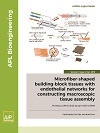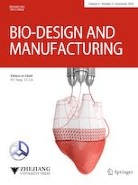
APL Bioengineering
Scope & Guideline
Empowering Discoveries in Bioengineering and Beyond
Introduction
Aims and Scopes
- Tissue Engineering and Regenerative Medicine:
Research on scaffolds, hydrogels, and bioprinting techniques aimed at developing functional tissues for therapeutic applications. - Mechanobiology:
Studies exploring the effects of mechanical forces on cellular behavior, tissue development, and disease processes, often utilizing advanced imaging and modeling techniques. - Bioelectronics and Biosensors:
Development of electronic devices and sensors that interface with biological systems for monitoring, diagnostics, and therapeutic applications. - Nanotechnology in Medicine:
Application of nanomaterials and nanotechnology for drug delivery, imaging, and therapeutic enhancements in various medical contexts. - Cancer Biology and Therapeutics:
Investigations into the mechanobiology of cancer, immune interactions, and the development of novel therapies targeting cancer cells. - Microfluidics and Organ-on-a-Chip Technologies:
Innovative systems that mimic human organ functions for drug testing and disease modeling, facilitating high-throughput analysis and personalized medicine. - Immunotherapy and Cell Therapy:
Research focused on enhancing the efficacy and safety of cell-based therapies, including CAR T-cell therapies and immune checkpoint modulation. - Biomaterials Science:
Exploration of new materials for medical applications, focusing on their biocompatibility, functionality, and integration with biological tissues.
Trending and Emerging
- Personalized Medicine and Patient-Specific Models:
There is a growing emphasis on tailoring medical treatments to individual patient profiles using engineered tissues and organ-on-a-chip technologies. - Advanced Imaging Techniques:
Innovations in imaging modalities, including photothermal therapy and terahertz imaging, are gaining traction for their ability to provide detailed insights into biological processes. - Artificial Intelligence and Machine Learning:
Utilization of AI in bioengineering for predictive modeling, image analysis, and data interpretation is rapidly increasing, enhancing research capabilities across various applications. - Smart Biomaterials and Responsive Systems:
Development of materials that respond to environmental stimuli (e.g., temperature, pH) for controlled drug release and tissue engineering applications is on the rise. - Sustainable and Green Technologies:
Research is increasingly focusing on environmentally friendly materials and processes, reflecting a broader commitment to sustainability in the field of bioengineering. - Integrative Approaches to Cancer Treatment:
Emerging strategies that combine immunotherapy, gene therapy, and mechanobiology are becoming central to innovative cancer treatment paradigms. - Regenerative Approaches for Neurodegenerative Diseases:
Innovative strategies targeting neuroregeneration using stem cells and biomaterials are gaining prominence, particularly for conditions like Alzheimer's and Parkinson's.
Declining or Waning
- Traditional Drug Delivery Systems:
There has been a noticeable shift towards more advanced and targeted drug delivery mechanisms, such as nanotechnology and gene delivery systems, leading to a decline in studies focusing on conventional methods. - Basic Biochemical Studies:
Research that focuses purely on biochemical mechanisms without integrating engineering aspects is becoming less common, as the interdisciplinary approach is favored. - Animal Models for Drug Testing:
With the rise of organ-on-a-chip and microfluidic technologies, reliance on traditional animal models for drug efficacy testing is decreasing as researchers seek more human-relevant models. - Static Cell Culture Systems:
The focus is shifting towards dynamic and physiological models that better mimic the in vivo environment, resulting in a decline in studies utilizing static cultures. - Single-Use Bioreactors:
As the field moves towards more sustainable and integrated manufacturing processes, interest in single-use bioreactor systems is waning in favor of reusable and modular bioprocessing technologies.
Similar Journals

Cellular and Molecular Bioengineering
Bridging Disciplines for Groundbreaking Scientific DiscoveryCellular and Molecular Bioengineering, published by SPRINGER, is a prominent journal dedicated to the exploration of interdisciplinary approaches in the fields of biochemistry, genetics, and molecular biology. With an ISSN of 1865-5025 and an E-ISSN of 1865-5033, this journal has been a pivotal resource since its inception in 2009, showcasing groundbreaking research that combines innovative modeling and simulation techniques with cellular and molecular applications. As a Q2 journal in both Biochemistry, Genetics and Molecular Biology (miscellaneous) and Modeling and Simulation categories, it ranks favorably in the Scopus metrics, placing 62nd out of 324 in Mathematics_ Modeling and Simulation, and 69th out of 221 in General Biochemistry, Genetics and Molecular Biology. The journal's commitment to quality research and its contribution to advancing academic dialogue make it essential for researchers, professionals, and students seeking to stay at the forefront of bioengineering innovation. While it currently does not offer open access, it continues to provide significant insights and empirical studies that can help shape future developments in the field, reinforcing its role as a key player in cellular and molecular bioengineering.

Biomaterials Advances
Innovating Tomorrow's Solutions in BiomaterialsBiomaterials Advances is a premier journal published by Elsevier, dedicated to the rapidly evolving field of biomaterials. Established in the United Kingdom, this open-access journal aims to disseminate high-quality, peer-reviewed research that explores innovative biomaterial designs and their applications in bioengineering and biomedical engineering. With an impressive 2023 impact factor reflected in its Q1 rankings across multiple categories—including Bioengineering, Biomaterials, and Biomedical Engineering—Biomaterials Advances stands out as a critical platform for scholars and practitioners faced with advancing technologies and methodologies in the realm of materials science. Covering a broad range of topics, from biocompatibility to tissue engineering, this journal provides an inclusive forum for researchers seeking to contribute to the field. Its Scopus rankings further affirm its position as a leading resource, with notable standings in Biomedical Engineering (Rank #13), Biomaterials (Rank #8), and Bioengineering (Rank #11), all within the top percentiles. Researchers and students alike are encouraged to contribute and engage with the latest findings and innovations in biomaterials through this valuable publication.

Annual Review of Biomedical Engineering
Catalyzing Interdisciplinary Insights in Biomedical EngineeringAnnual Review of Biomedical Engineering, published by Annual Reviews, stands as a leading academic journal dedicated to the rapidly evolving field of biomedical engineering. With an impressive impact factor that reflects its high citation rates and rigorous peer-review process, this journal offers critical insights by synthesizing cutting-edge advancements and applications in both biomedical engineering and miscellaneous medicine. The journal, which is available in both print (ISSN: 1523-9829) and electronic formats (E-ISSN: 1545-4274), serves as an essential resource for researchers, professionals, and students aiming to stay abreast of significant developments and emerging trends. As of 2023, it is recognized in the top tier (Q1) for both Biomedical Engineering and Medicine, showcasing its esteemed position within the academic community, reflected in its high Scopus rankings. Spanning from 1999 to 2024, the Annual Review of Biomedical Engineering continues to catalyze interdisciplinary collaboration and innovation at the intersection of engineering and healthcare.

Advanced NanoBiomed Research
Bridging Disciplines for a Healthier TomorrowAdvanced NanoBiomed Research is a pioneering open-access journal committed to advancing the interdisciplinary field of nanobiotechnology, published by WILEY-V C H VERLAG GMBH. Since its inception in 2021, this journal has provided a platform for innovative research that bridges the gap between engineering, medicine, and materials science. With impressive rankings in Scopus, positioning it within the top quartiles of various categories, Advanced NanoBiomed Research aims to disseminate high-quality research that contributes to the understanding and application of nanomaterials in biomedical contexts. As it encompasses a wide scope—from applied microbiology to biomaterials—it serves as an essential resource for researchers, professionals, and students eager to explore the cutting-edge developments in the field. The journal promotes a collaborative environment where emerging ideas can flourish, ensuring that vital advancements in nanobiomedicine can be shared and built upon within the scientific community.

Advanced Biology
Exploring the Frontiers of Biochemistry and GeneticsAdvanced Biology, published by WILEY-V C H VERLAG GMBH, serves as a premier platform where innovative research and scientific breakthroughs in the fields of biochemistry, genetics, and molecular biology converge. Established in 2021, this journal has rapidly ascended to prominence, securing Q1 rankings in its primary categories, including general biochemistry and biomedical engineering, and a solid Q2 ranking in biomaterials. With an ISSN of 2701-0198 and an emphasis on open access, Advanced Biology ensures that rigorous peer-reviewed research is accessible to a global audience, enhancing visibility and fostering collaboration among researchers, professionals, and students alike. By 2024, it aims to continually elevate scientific understanding and innovation, catering to the growing interdisciplinary nature of these critical fields. With Scopus rankings placing it amongst the top quartiles in its disciplines, Advanced Biology is poised to make significant contributions to the future of life sciences.

Current Opinion in Biomedical Engineering
Empowering researchers with impactful reviews.Current Opinion in Biomedical Engineering is a renowned journal published by Elsevier, focusing on the cutting-edge developments and critical assessments in the fields of biomedical engineering and related disciplines. With an ISSN of 2468-4511, it provides a valuable platform for researchers and professionals to disseminate their insights and discoveries in areas such as bioengineering, biomaterials, and medicine. Its impressive impact factor positions it in the Q2 category for several fields, including Bioengineering and Biomedical Engineering, highlighting its influence and relevance in ongoing scientific dialogues. The journal’s unique format of opinion pieces and reviews encourages innovative thinking and fosters collaboration among experts. As an essential resource for those engaged in the life sciences and engineering, Current Opinion in Biomedical Engineering serves to stimulate discussion, promote knowledge exchange, and drive advancements in biomedical applications. Set in the Netherlands at Radarweg 29, 1043 NX Amsterdam, the journal is accessible through various academic platforms, enabling a global readership to engage with the latest scholarly work in this dynamic field.

Bio-Design and Manufacturing
Advancing the Future of Biomedical EngineeringBio-Design and Manufacturing, published by SPRINGER HEIDELBERG, is a pioneering journal that stands at the forefront of innovation in the fields of Biomedical Engineering, Biotechnology, Industrial and Manufacturing Engineering, and Materials Science. With its ISSN 2096-5524 and E-ISSN 2522-8552, this journal has established itself as a leading platform for disseminating cutting-edge research and advancements that merge biological principles with manufacturing processes, emphasizing sustainable and efficient practices. It has garnered recognition in the 2023 category quartiles, boasting a Q1 rank in all its relevant fields, which underscores its significance and impact—evident from its prime Scopus rankings that place it within the top percentiles of numerous engineering and materials science disciplines. Researchers, professionals, and students alike benefit from the wealth of knowledge presented in this journal, making it an essential resource for those seeking to enhance their understanding of bio-design applications and innovation in manufacturing processes.

Materials Today Bio
Pioneering research that shapes the landscape of biomedical engineering.Materials Today Bio, published by Elsevier, is an esteemed open-access journal dedicated to advancing the fields of bioengineering, biomaterials, and biomedical engineering. Since its inception in 2019, this journal has quickly made a name for itself, currently ranked Q1 in multiple categories including Bioengineering, Biomaterials, and Biotechnology, reflecting its exceptional quality and relevance in the rapidly evolving landscape of bio-related sciences. With an impressive Scopus ranking positioning it in the top 25% of its categories, Materials Today Bio provides a vital platform for researchers and professionals to share cutting-edge discoveries and innovative applications that bridge the gap between materials science and biological studies. Accessible to a global audience, this journal not only fosters collaboration among the scientific community but also aims to highlight significant advancements in cell and molecular biology, making it an indispensable resource for students and seasoned experts alike. The journal's commitment to open access since 2019 underscores its dedication to disseminating knowledge widely, ensuring that crucial findings reach those who can benefit from them the most.

Biomaterials Research
Unveiling the potential of biomaterials for healthcare.Biomaterials Research, published by the American Association for the Advancement of Science, is a prominent open access journal established in 2014, dedicated to advancing the field of biomaterials. Based in the United Kingdom, this journal has swiftly become an essential platform for researchers and practitioners, offering groundbreaking insights in biomaterials, biomedical engineering, ceramics and composites, and miscellaneous medical fields. With its impressive Q1 ranking across multiple relevant categories in 2023 and its strong Scopus rankings, including a remarkable 90th percentile in the medicine category, Biomaterials Research showcases high-quality, peer-reviewed research designed to address both practical and theoretical challenges in biomaterials science. As an open access journal, it promotes wider dissemination and accessibility of research findings, crucial for fostering innovation and collaboration within the scientific community. Researchers, professionals, and students alike are encouraged to contribute, read, and engage with the latest developments in this dynamic field.

VIEW
Elevating Knowledge in Biomaterials and Biomedical Engineering.VIEW is a prestigious journal published by WILEY that focuses on the rapidly evolving fields of Biomaterials and Biomedical Engineering. Since its inception in 2020, VIEW has established itself as an open-access platform dedicated to disseminating high-quality research and innovation within these disciplines. With an impressive impact factor that places it in the Q1 category of both Biomaterials and Biomedical Engineering, VIEW ranks among the top journals in its field, boasting a 91st percentile ranking in Biomedical Engineering and an 85th percentile ranking in Materials Science. Researchers, professionals, and students are encouraged to utilize this invaluable resource, as it provides a comprehensive view of current advancements and future trends in biomaterial science and engineering. Positioned in the United Kingdom, VIEW operates as a vital scholarly communication link, fostering collaboration and knowledge sharing within an ever-growing global community.